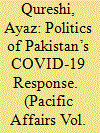| Srl | Item |
| 1 |
ID:
193630


|
|
|
|
|
| Summary/Abstract |
Drawing on a variety of material—mass and social media texts, government reports, and everyday observations—this article examines two interrelated dynamics in Malaysia in 2020–2021: the COVID-19 pandemic’s unfolding local trajectory and the short-lived Perikatan Nasional (PN) coalition’s governance capacity. Despite political instability resulting from this government’s rise to power following internal political manouevrings, it managed to effectively control a major wave of cases with the help of a centralized healthcare system manned by permanent professional staff and the imposition of coercive measures. Thus, Malaysia’s success in “governing” the early phase of the pandemic is arguably attributable to its strong state infrastructure, notwithstanding the untimely unfolding of this political coup. However, an ideal type approach—that is, concern with state capacity—is inadequate in making sense of subsequent failures to control the pandemic after a state election took place several months later. Using Migdal’s “state-in-society” approach, this article focuses on the political process of pandemic governance to shed light on Malaysia’s shifting state capabilities. Arguably, the resulting shifting responses were mainly shaped by: (1) continuous partisanship; (2) PN’s internal fragmentation; (3) PN’s complacency in initially “flattening the curve”; and (4) poor governance during the state election.
|
|
|
|
|
|
|
|
|
|
|
|
|
|
|
|
| 2 |
ID:
187420


|
|
|
|
|
| Summary/Abstract |
This paper takes a “state-in society” approach to understanding the evolution of Pakistan’s COVID-19 response, which was laid claim to and contested by multiple agencies within and adjacent to the state, and by multiple levels of government. The capacity of the health system of Pakistan was already overstretched by the needs of its population but in recent years it has been hamstrung by ongoing protests by the medical community concerning the privatization of public-sector hospitals, to which were added protests over the lack of personal protective equipment in the public sector. These protests resulted in frequent closures of outpatient departments at major hospitals. When the government announced a relief package to mitigate the effects of COVID-19, traders and big businesses lobbied the government to obtain the lion’s share in the form of concessions such as loan deferments and tax refunds. The government touted the unconditional cash grants program but the cash for the poor could not be disbursed effectively due to the absence of local governments at the grassroots level. As an appropriate response to the pandemic, especially in relation to the lockdown policies, was contested and negotiated among multiple actors in the Pakistani state and society, the Pakistani military emerged as a dominant force in this “field of power.”1 In this paper, I present an account of Pakistan’s response to COVID-19 as it evolved in 2020 and discuss the implications for democratic culture in Pakistan.
|
|
|
|
|
|
|
|
|
|
|
|
|
|
|
|